Garden Design Study Group: Moore Garden
Park Orchards, Victoria
Background Data
Sources |
Garden Visit, November 2014 Interview with owners. |
Area |
0.4 hectares (1 acre), steep, south facing. |
Overlays |
Heritage overlay. |
Climate |
Cool temperate. |
Soil |
Clay soil over shale. |
Mulch |
Shredded branches and leaves from property. |
Photographs |
Diana Snape and Tony Moore. |
Click on the smaller images to view larger images.
The Property
Brenda and Tony have one of the few remaining large, privately-owned native gardens in Melbourne which, alas, is soon to be in other hands as they are downsizing in 2015. It is salient, therefore, that this most interesting and attractive garden be recorded before that time and it has been my privilege to take on the task.
The suburb of Park Orchards lies 23 km north-east of the Melbourne CBD and was developed mainly in the 1950s with a post office opening there in 1959. To some extent it was envisaged as a model estate, with curving streets following the lie of the land and areas of natural bush-land left intact. The allotments were large, and the Moore property is on a south-facing, very steep block of just over 0.4 ha. (one acre) with a slope of 1 in 3 in most places. Their street is circular with a central area of woodland which provides a welcome addition of borrowed landscape. Nevertheless, when Tony and Brenda built their home in 1971 the block was covered with pine-trees and weed plants (Cotoneaster, Pittosporum, blackberries, etc.), but thanks to their Herculean efforts it now contains mainly indigenous trees, shrubs and grasses, some of it remnant vegetation including Eucalyptus goniocalyx, Exocarpos cupressiformis, Kunzea ericoides, Bursaria spinosa, Banksia marginata and Microlaena stipoides.
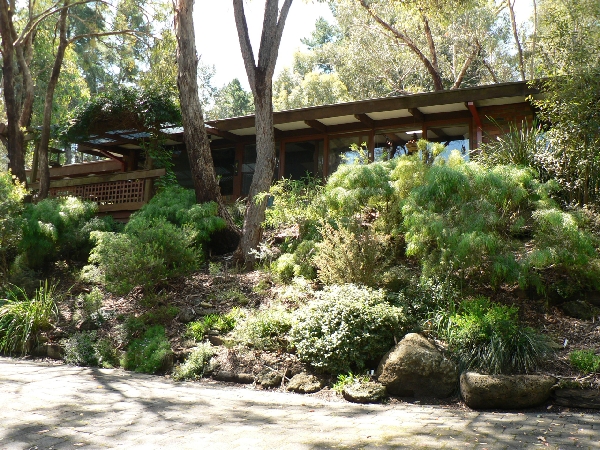
View of house – front
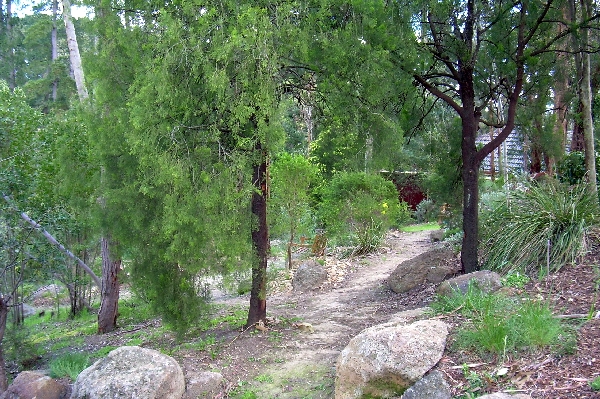 |
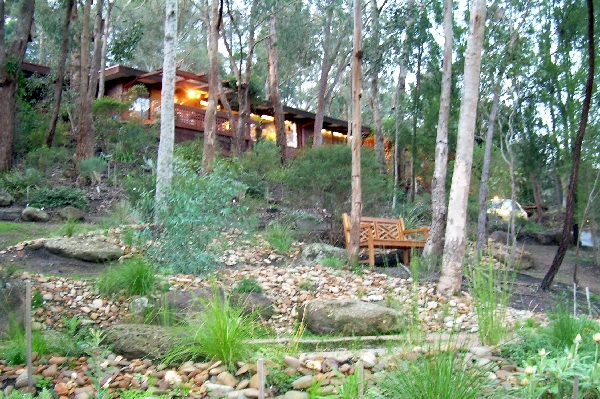 |
|
| Left: Path through Exocarpos Right: View uphill to house |
||
The house was designed to be long and narrow and to lie across the fall line of the hill, thus minimizing the height of the cliff behind the house and allowing light to penetrate through the rear windows. The long driveway cuts across the block to reduce the steepness and allow for car-parking at the house level. The windows all look out to interesting views of the garden and distant hills, while large windows at the front of the house allow maximum light to enter. Many of the eucalypts planted in the early 70’s are still flourishing, providing wonderful views downhill from these windows. They include the indigenous Eucalpytus viminalis and E.goniocalyx, E.maculata, E. leucoxylon, E. cephalocarpa, E. polyanthemos and E. sideroxylon. Banksias are another prominent genus in the garden, loved not only by Brenda but also by the black cockatoos, while the semi-parasitic Cherry Ballarts (Exocarpos cupressiformis) have established themselves throughout the garden.
The Garden Conditions
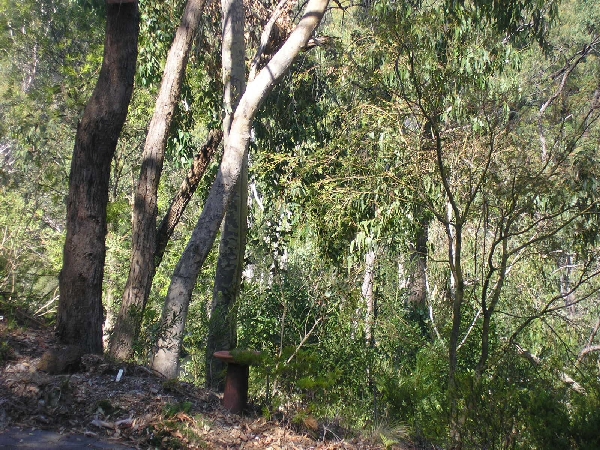 |
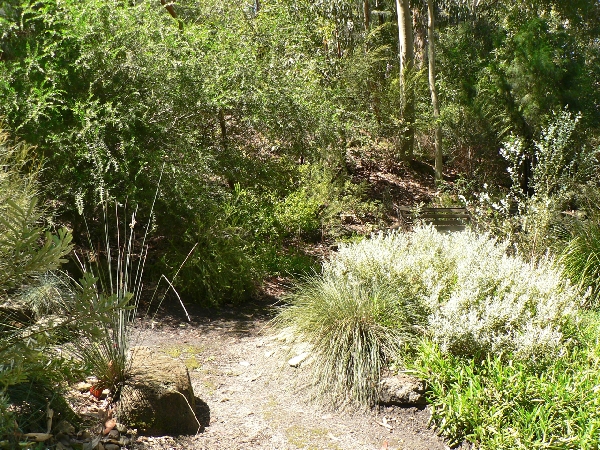 |
|
| Left: Light and shade on steep slope Right: Gravel track |
||
The ground is solid and very dry, consisting of cracked shale covered by a thin layer of clay top-soil – quite a challenge for any gardener! As Brenda points out, the steep slope of the block means that any good soil has washed down the valley in past millennia. Because of these difficult conditions, drought-resistant indigenous vegetation is the mainstay of the garden, but, in recent years, Brenda and Tony have found that eremophilas do well here as do acacias, correas, grevilleas, pomaderris and other hardy species. Apart from the nutrient-poor soils, the main challenges facing the gardener are the steepness of the slope which makes working conditions difficult, the heavy shade and the large tree-roots throughout most of the garden.
The Back Garden
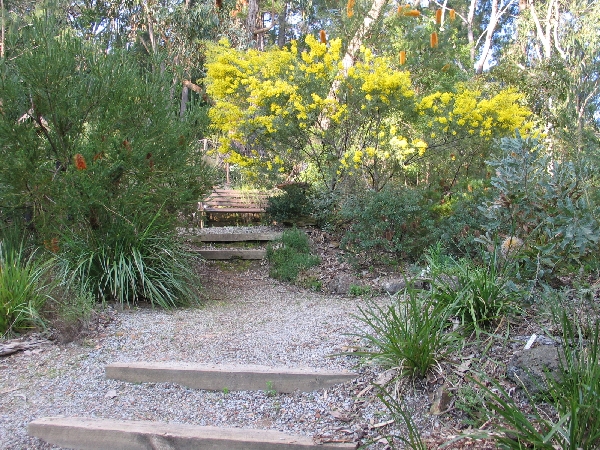 |
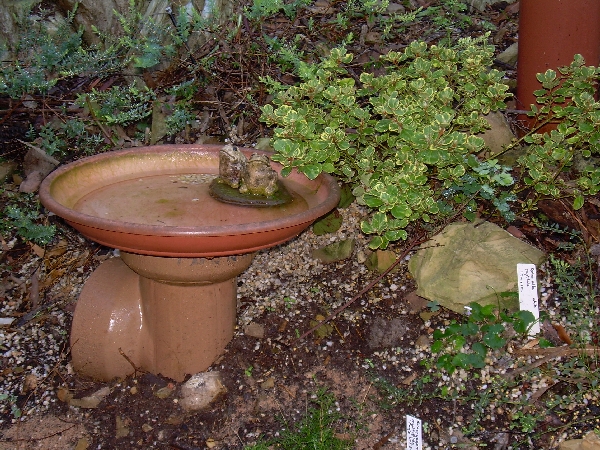 |
|
| Left: Recycled sleepers Right: Water and rocks |
||
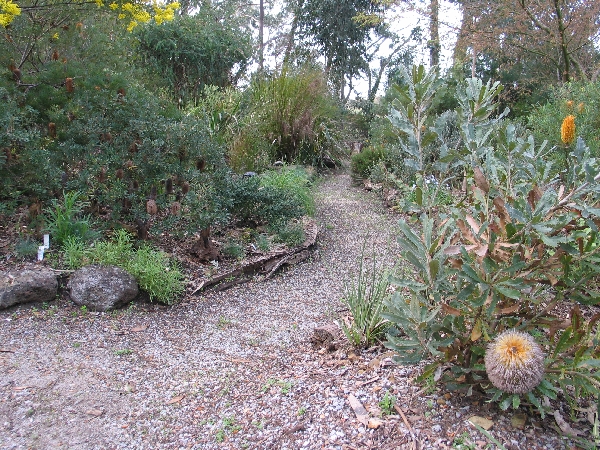 |
|
Meandering paths |
The steep back garden is terraced, with flattened, winding paths to make access easier and recycled sleepers for steps (which have been kept to a minimum). Swales have been created to channel and control rainwater and direct it to the built-up garden beds between the paths. When Tony and Brenda’s children were young a part of the back garden was levelled to provide a swimming-pool for the family and its removal now makes a pleasantly flat sitting spot close to the house. Water remains an important element, however, as Tony, who has a penchant for frog-ponds, has created a small one nearby, while the many bowls of water placed at numerous spots around the garden provide enjoyment for both the birds and the observers.
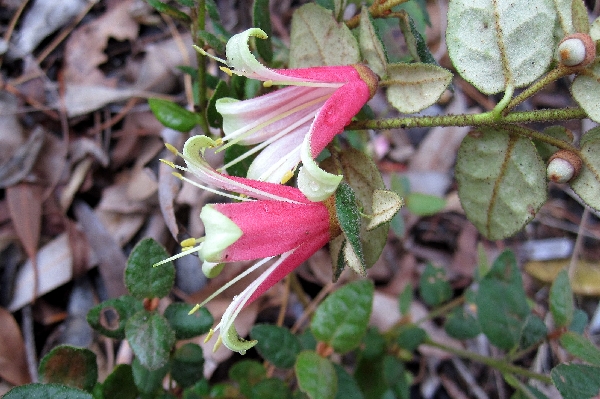 |
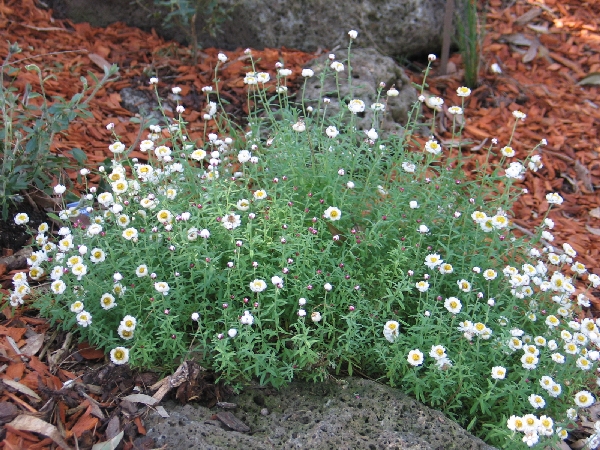 |
|
| Left: Correa sp. Right: Rhodanthe anthemoides |
||
Repeat plantings tie this meandering garden together. As well as the original and now very large trees, many of them box eucalypts, other trees and large shrubs planted over the years include several species of banksias, prostanthera, acacias (including Acacia cognata, both large and dwarf forms), leptospermum, bursaria and kunzea. Brenda is a very competent propagator, and thus repeat plantings of small shrubs, ground-covers and strappy plants are a feature of this garden, providing interest and colour all year round: correas, croweas, scaevolas, bulbine lilies, thomasias, orthrosanthus, eremophilas, rhodanthe, zierias, lomandra and dianellas to name just a few of the many plants flourishing here.
Brenda also uses garden ornaments and container plants to add interest and zest to the garden. A trellis holds pots of orchids as do hollow logs, while pots of all sizes contain eye-catching ‘fuss-pots’ as well as old favourites. Two large, rusted-steel brolgas watch over the garden and there are several other native bird and animal sculptures or ornaments throughout the garden and along the verandahs. An impressive seat from Bali provides a favourite resting spot near the nursery area. The heavy work is done by Tony who does the digging and mulching, chain saw pruning and moving stuff around the garden – no mean feat on this very steep block.
The Front Garden
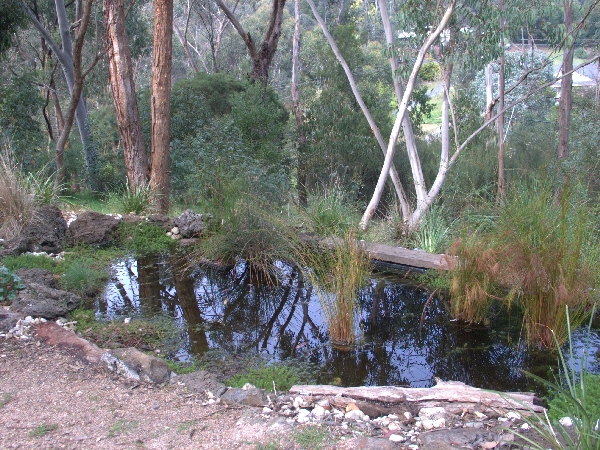 |
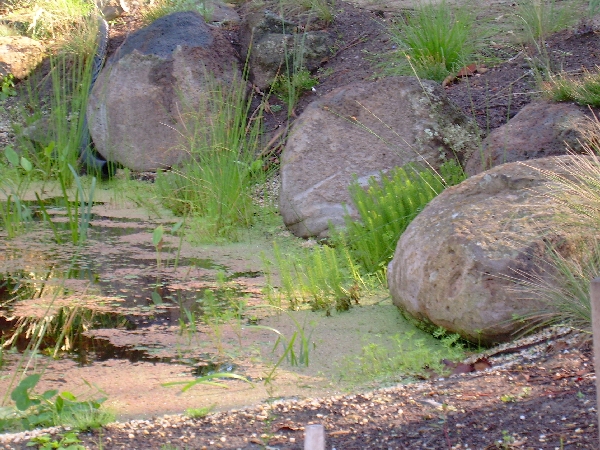 |
|
| Left: Reflections in pond Right: Boulders around pond |
||
Water is also an important part of the front garden. A few years ago, Bev Hanson, landscape gardener extraordinaire and stalwart of the GDSG and APS Vic., designed a new entrance to the property using dramatically large rocks and boulders. At the same time, the two existing ponds were redesigned, and, in one case, deepened and enlarged, with carefully-chosen water-plants providing a habitat for the resident frogs and numerous water-birds who visit the garden. Frogs include Pobblebonks, Southern Brown Tree Frogs and Eastern Common Froglets. There are also skinks, lizards and bats and in recent years a pair of Black Pacific Ducks visits frequently. Brenda and Tony are delighted with the makeover, as they feel the rock-work gives the whole area a much more relaxed and natural look and the same rocks used along the cobble-stoned driveway provide a visual link with the ponds.
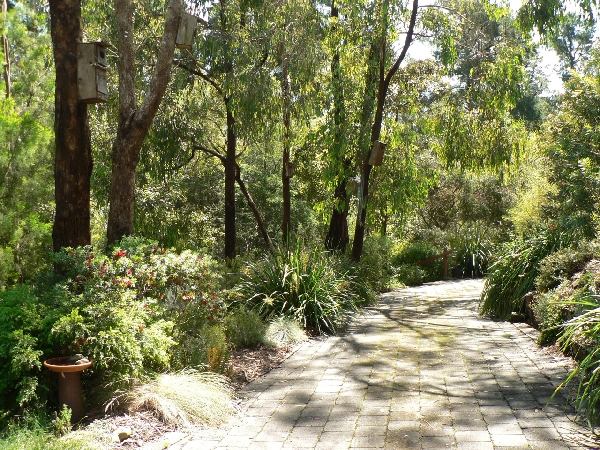 |
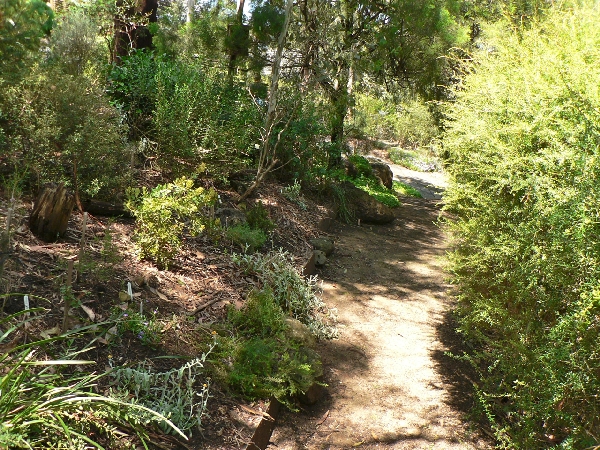 |
|
| Left: Mass and void Right: Path across hill |
||
Because of the open, gravelled areas around the ponds, the long verandahs, the several sitting spaces in both the front and back gardens and the spots where native grasses or ground-covers fill the role of lawns, the garden adheres to the concept of creating mass and void in good garden design. There are a few exotics such as two of the original pine-trees as well as camellias and succulents which blend into this over-whelmingly native-garden and a very large oak-tree stands at the front of the garden – after all, Tony is English!
The Garden Philosophy and the Owners’ Objectives
This garden is an ecological model. All green waste, small branches and kitchen-scraps are composted or mulched and returned to the garden, and no poison or pesticides are used. Cats are not welcome. Three linked water-tanks hold about 10,000 litres of water collected from the roof gutter system, while a pump not only enables garden-watering but also provides regular, computerised watering for the nursery plants. The overflow from the tanks is piped underground to supply the East pond and a further pipe system supplies the larger West pond directly from the roof. Water from the back gutter of the car-port roof is diverted onto an area of the garden via a slotted pipe, whilst water from the front of the car-port fills a small pond close to the house.
The property has had Land for Wildlife status since July 2002 and Brenda says they have counted around forty species of birds in this bush-land garden haven. Bronze-winged pigeons are nearly always wandering the garden and Eastern Rosellas have nested here. Crimson Rosellas and King Parrots are also regular visitors. Sugar Gliders, and Ringtail and Brushtail Possums use the nest-boxes at times, although the visiting Powerful Owl has fed on a few of the Sugar Gliders, leaving only their tails behind. Koalas and Wallabies are rare sightings.
The Moore’s stated objective in establishing the garden was to create an Australian, casual, bushland-style garden that would provide habitat for wild-life, and this has most certainly been achieved. The original challenges were many. Besides the steepness, dry shade and poor, stony soil there was cape-weed from a neighbouring garden and a plethora of pine-trees (they removed fifteen of these but getting permission to do so took some time as it is a heritage area and the pines were regarded by the powers-that-be as part of the area’s history). What Brenda now loves most about this garden is its relaxed, comforting feel and the fact that it is enjoyed so much by the grand-children. She says she has always had a passion for gardening as she grew up on a large property in North Melbourne built by her Grandfather, and she likes to garden in blocks of time – she’s definitely not a ‘potterer’.
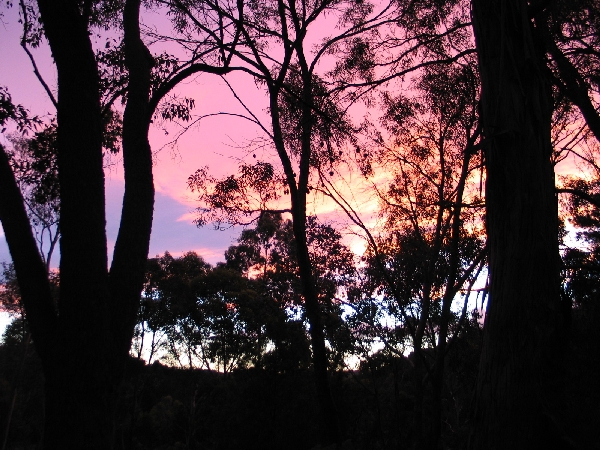
Evening view through windows
In recent years the garden has featured in the Open Gardens Australia scheme. In 2007, the Moore garden received First Place in the Sustainable Garden Award from the combined districts of Banyule, Middle Yarra, Manningham and Nillumbik – a great achievement and a fitting reward for all the skill, creativity and hard work Brenda and Tony have dedicated to their garden.
Eleanor Hodges
February 2015
 Australian Native Plants Society (Australia)
Australian Native Plants Society (Australia)